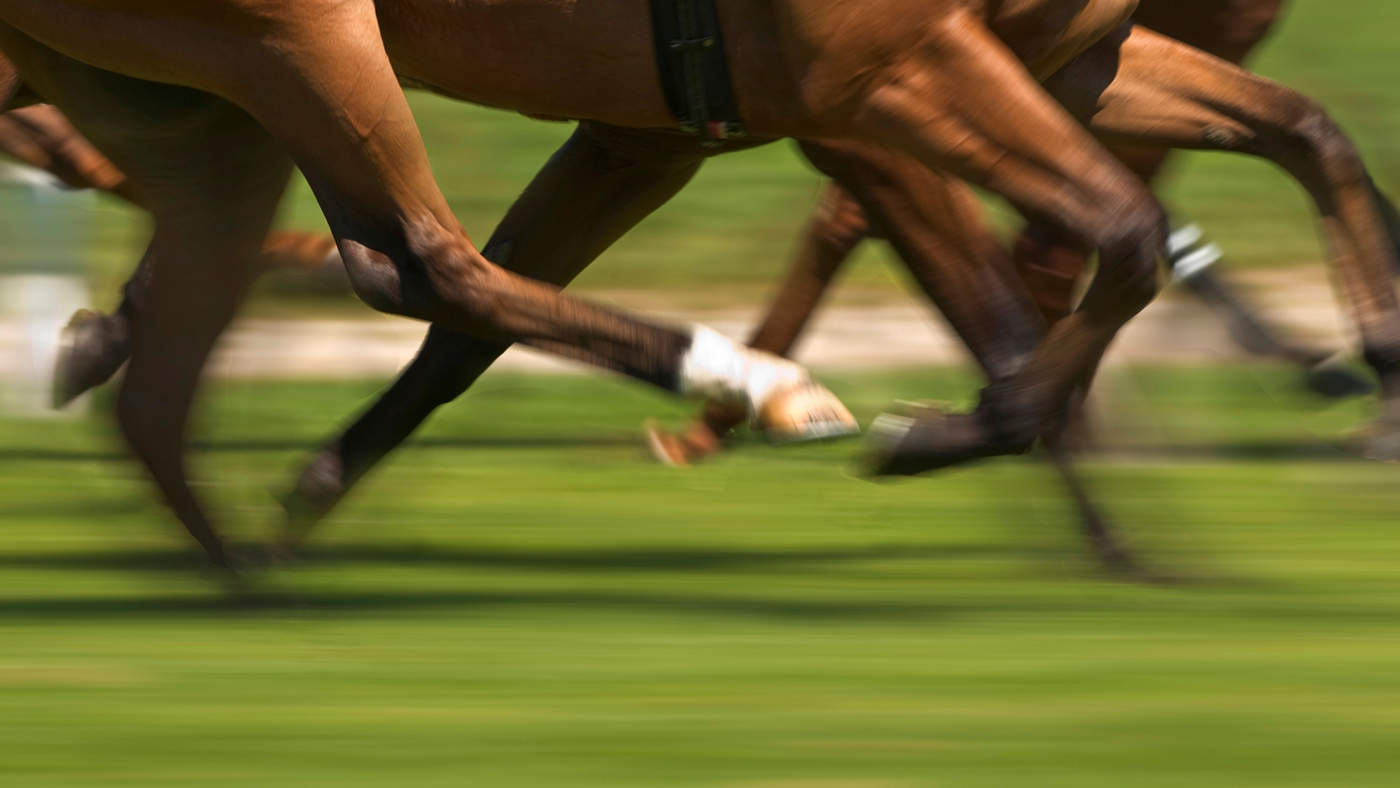New ways to keep track of what happens to horses in Britain after leaving racing are being developed, including a system to log what happens to each equine when their careers come to an end. Other plans being headed by the British Horseracing Authority (BHA) and Retraining of Racehorses (RoR) include simplifying associated paperwork and creating a rule to ensure accurate information is collected.
Allegations about the welfare of racehorses leaving the sport made international headlines this year after a TV documentary that showed shocking scenes of treatment of horses in slaughterhouses in Australia. But the alleged situation is extremely different to and in no way representative of UK reality.
{"content":"PHA+QXJvdW5kIDcsMDAwIGhvcnNlcyBsZWF2ZSB0cmFpbmluZyBpbiB0aGUgVUsgZWFjaCB5ZWFyIGFuZCBtdWNoIGlzIGFscmVhZHkgaGFwcGVuaW5nwqB0byBlbnN1cmUgdGhlaXIgd2VsZmFyZSwgYnV0IG1ham9yIGRldmVsb3BtZW50cyBhcmUgcGxhbm5lZCB3aXRoIHRoZSBhaW0gb2YgYmV0dGVyIHVuZGVyc3RhbmRpbmcgd2hhdCBoYXBwZW5zIGF0IGVhY2ggc3RhZ2Ugb2YgcmFjZWhvcnNlc+KAmcKgbGl2ZXMuPC9wPgo8cD5TaW5jZSBKYW51YXJ5IDIwMTgsIGZvYWwgYmlydGhzIG11c3QgYmUgcmVnaXN0ZXJlZCB3aXRoaW4gMzAgZGF5cywgZG93biBmcm9tIGEgeWVhci4gQnJpdGlzaCByYWNpbmfigJlzIEhvcnNlIFdlbGZhcmUgQm9hcmQsIHdoaWNoIG1ldCBmb3IgdGhlIGZpcnN0IHRpbWUgaW4gQXByaWwsIGlzIHdvcmtpbmcgb24gcHJvamVjdHMgbGlua2luZyB0byBsaWZlbG9uZyB0cmFjZWFiaWxpdHkgYW5kIHdlbGZhcmUgb2YgdGhvcm91Z2hicmVkcywgZnJvbSB0aGUgZGF0YWJhc2UgdG8gYSB3ZWxmYXJlIGFzc2Vzc21lbnQgdG9vbCBhbmQgYW4gYXBwcm9wcmlhdGUgZXV0aGFuYXNpYSBwb2xpY3kuPC9wPgo8cD5UaGUgaG9wZSBpcyB0aGVzZSBjb21iaW5lZCB3aWxsIGdpdmUgdGhlIGluZHVzdHJ5IGdyZWF0ZXIgaW5zaWdodCBvbiB3aGV0aGVyIHRoZXJlIGFyZSBpbmNoIHBvaW50cyBvciByZWQgZmxhZ3Mgd2hlcmUgcHJvYmxlbXMgb3IgbG9zcyBvZiBob3JzZXMgY291bGQgYmUgbWluaW1pc2VkLjwvcD4KPHA+PGRpdiBjbGFzcz0iYWQtY29udGFpbmVyIGFkLWNvbnRhaW5lci0tbW9iaWxlIj48ZGl2IGlkPSJwb3N0LWlubGluZS0yIiBjbGFzcz0iaXBjLWFkdmVydCI+PC9kaXY+PC9kaXY+PHNlY3Rpb24gaWQ9ImVtYmVkX2NvZGUtMzEiIGNsYXNzPSJoaWRkZW4tbWQgaGlkZGVuLWxnIHMtY29udGFpbmVyIHN0aWNreS1hbmNob3IgaGlkZS13aWRnZXQtdGl0bGUgd2lkZ2V0X2VtYmVkX2NvZGUgcHJlbWl1bV9pbmxpbmVfMiI+PHNlY3Rpb24gY2xhc3M9InMtY29udGFpbmVyIGxpc3RpbmctLXNpbmdsZSBsaXN0aW5nLS1zaW5nbGUtc2hhcmV0aHJvdWdoIGltYWdlLWFzcGVjdC1sYW5kc2NhcGUgZGVmYXVsdCBzaGFyZXRocm91Z2gtYWQgc2hhcmV0aHJvdWdoLWFkLWhpZGRlbiI+DQogIDxkaXYgY2xhc3M9InMtY29udGFpbmVyX19pbm5lciI+DQogICAgPHVsPg0KICAgICAgPGxpIGlkPSJuYXRpdmUtY29udGVudC1tb2JpbGUiIGNsYXNzPSJsaXN0aW5nLWl0ZW0iPg0KICAgICAgPC9saT4NCiAgICA8L3VsPg0KICA8L2Rpdj4NCjwvc2VjdGlvbj48L3NlY3Rpb24+PC9wPgo8cD7igJxNZWFzdXJlcyBhcmUgYWxyZWFkeSBiZWluZyBpbnRyb2R1Y2VkIHRvIGluY3JlYXNlIEJyaXRpc2ggcmFjaW5n4oCZcyBhYmlsaXR5IHRvIGtlZXAgdHJhY2sgb2YgdGhvcm91Z2hicmVkcywgYmVmb3JlIHRoZXkgZW50ZXIgdHJhaW5pbmcgYW5kIGFmdGVyIHRoZWlyIHJhY2luZyBjYXJlZXJzLOKAncKgUm9SIGNoaWVmIGV4ZWN1dGl2ZSBEaSBBcmJ1dGhub3QgdG9sZCA8ZW0+SCZhbXA7SDwvZW0+LjwvcD4KPHA+4oCcVGhlIEJIQSBhbmQgUm9SIHdpbGwgYmUgd29ya2luZyBjbG9zZWx5IHRvZ2V0aGVyIHRvIHN0cmVuZ3RoZW4gdGhlIGJyaWRnZSBiZXR3ZWVuIHRoZSBkZXRhaWxlZCBkYXRhIHJhY2luZyBoYXMgb2YgaG9yc2VzIGluIHRyYWluaW5nIGFuZCB0aGUgZGF0YSBSb1IgaGFzIG9mIGhvcnNlc8KgYWN0aXZlIGluIHNlY29uZCBjYXJlZXJzLjwvcD4KPHA+4oCcV2UgcmVjb2duaXNlIHRoZXJlIGlzIHNjb3BlIHRvIGRvIG1vcmUgdG8ga2VlcCB0cmFjayBvZiBob3JzZXMgZm9sbG93aW5nIHJhY2luZyBhbmQgdGhpcyB3aWxsIGJlIGEgcHJpb3JpdHkgZm9yIFJvUiBhbmQgQkhBIGluIDIwMjAuIE1lYXN1cmVzIHdpbGwgYWxzbyBiZSBpbnRyb2R1Y2VkIHRvIGluY3JlYXNlIGF3YXJlbmVzcyBvZiB0aGUgb3B0aW9ucyBhdmFpbGFibGUsIGhvdyBSb1IgY2FuIGhlbHAgb3duZXJzIGFuZCB0cmFpbmVycyBhbmQgZW5zdXJpbmcgbW9yZSBob3JzZXMgYXJlIHJlZ2lzdGVyZWQgd2l0aCBSb1IsIGFuZCBzb29uZXIsIGFuZCBtYWtpbmcgb3duZXJzIGF3YXJlIG9mIHRoZWlyIHJlc3BvbnNpYmlsaXRpZXMgdW5kZXIgVUsgbGF3IHRvIHJlZ2lzdGVyIGFsbCB0cmFuc2ZlcnMgb2Ygb3duZXJzaGlwLuKAnTwvcD4KPGRpdiBjbGFzcz0iYWQtY29udGFpbmVyIGFkLWNvbnRhaW5lci0tbW9iaWxlIj48ZGl2IGlkPSJwb3N0LWlubGluZS0zIiBjbGFzcz0iaXBjLWFkdmVydCI+PC9kaXY+PC9kaXY+CjxwPk1ycyBBcmJ1dGhub3QgYWRkZWQgdGhlIGFmdGVyY2FyZSBzeXN0ZW0gYW5kIGluZnJhc3RydWN0dXJlIGluIEJyaXRhaW4gaXPCoOKAnGRlbW9uc3RyYWJseSBtb3JlIG1hdHVyZSB0aGFuIGluIG90aGVyIHJhY2luZyBqdXJpc2RpY3Rpb25z4oCdLjwvcD4KPHA+Um9SIGlzIGFsc28gaGVscGluZyBvdGhlciBjb3VudHJpZXMgc2V0IHVwIGFuZCBpbXByb3ZlIHN5c3RlbXMsIGFuZCBsZWFybiB3aGF0IHdvcmtzIHdlbGwgb3ZlcnNlYXMuPC9wPgo8ZGl2IGNsYXNzPSJhZC1jb250YWluZXIgYWQtY29udGFpbmVyLS1tb2JpbGUiPjxkaXYgaWQ9InBvc3QtaW5saW5lLTQiIGNsYXNzPSJpcGMtYWR2ZXJ0Ij48L2Rpdj48L2Rpdj4KPHA+VGhlIG9yZ2FuaXNhdGlvbiBoYXMgY2xvc2UgdG8gNiw4MDAgaG9yc2VzIHJlZ2lzdGVyZWQgYXPCoOKAnGFjdGl2ZeKAncKgaW4gYSBzZWNvbmQgY2FyZWVyOyAzLDQ2N8KgaW4gc2hvd2luZywgNCwxNDggaW4gZHJlc3NhZ2UgYW5kIDIsOTEyIGV2ZW50ZXJzLjwvcD4KPHA+4oCcVGhhbmtzIHRvIFJvUiwgQnJpdGlzaCByYWNpbmcgaGFzIGEgd2VsZmFyZSBzYWZldHkgbmV0LCB3aGljaCB0YWtlcyBpbiBhbmQgZnVuZHMgY2FyZSBvZiBmb3JtZXIgcmFjZWhvcnNlcywgd2hvIGJ1dCBmb3IgY2hhcml0YWJsZSBpbnRlcnZlbnRpb24gY291bGQgYmUgYXQgcmlzayzigJ3CoE1ycyBBcmJ1dGhub3QgYWRkZWQuPC9wPgo8ZGl2IGNsYXNzPSJhZC1jb250YWluZXIgYWQtY29udGFpbmVyLS1tb2JpbGUiPjxkaXYgaWQ9InBvc3QtaW5saW5lLTUiIGNsYXNzPSJpcGMtYWR2ZXJ0Ij48L2Rpdj48L2Rpdj4KPHA+4oCcT3ZlciB0aGUgcGFzdCBjb3VwbGUgb2YgeWVhcnMsIGFyb3VuZMKgMTAwwqBob3JzZXMgYSB5ZWFyIGhhdmUgcmVjZWl2ZWQgdGhlIGJlbmVmaXQgb2YgZnVuZGluZy4gQSBmYXIgc21hbGxlciBudW1iZXIgb2YgaG9yc2VzIHJlY2VpdmUgYXNzaXN0YW5jZSB0aHJvdWdoIHRoZSBjaGFyaXR54oCZcyBlbWVyZ2VuY3kgcmVsaWVmIGZ1bmQu4oCdPC9wPgo8aDM+Um9vbSBmb3IgaW1wcm92ZW1lbnQ8L2gzPgo8cD5CSEEgZGlyZWN0b3Igb2YgZXF1aW5lIGhlYWx0aCBhbmQgd2VsZmFyZSBEYXZpZCBTeWtlcyBzYWlkIHRoZSBzaXR1YXRpb24gaXPCoOKAnGdvb2TigJ0sIGJ1dCB0aGVyZSBpcyByb29tIGZvciBpbXByb3ZlbWVudC48L3A+CjxwPuKAnEl0IGlzIHJlYWxseSBpbXBvcnRhbnQgZm9yIHRoZSBpbmR1c3RyeSB0byBnZXQgdGhpcyByaWdodCzigJ0gaGUgc2FpZC4g4oCcV2UgbmVlZCB0byBiZSBvcGVuLCB0cmFuc3BhcmVudCBhbmQgaGF2ZSB0cmFjZWFiaWxpdHkgYW5kIHdlbGZhcmUgaW5pdGlhdGl2ZXMuIENhcHR1cmluZyB0aGF0IGZpcnN0IHN0ZXAgaXMgb3VyIGFpbSBmb3IgbmV4dCB5ZWFyLjwvcD4KPHA+4oCcV2Ugd2FudCB0byBrbm93IHdoZW4gYSBob3JzZSBsZWF2ZXMgdHJhaW5pbmcgYW5kIHdoZXJlIGhlIGdvZXM7IGlmIGhl4oCZcyBnb2luZyB0byBoaXMgb3duZXIsIGJlaW5nIHJldGlyZWQsIG9yIHRvIGEgcmV0cmFpbmluZyBjZW50cmUuPC9wPgo8cD7igJxXZSB3b3VsZCBsaWtlIHRvIGJlIGFibGUgdG8gc2V0IHVwIHRoZSBzeXN0ZW0gc28gd2UgY2FuIGNhcHR1cmUgaWYgdGhhdCByZXRyYWluaW5nIGNlbnRyZSBzZWxscywgb3IgbW92ZXMgdGhlIGhvcnNlIG9uLCBzbyB3ZSBoYXZlIHRoZSBuZXh0IHN0YWdlIG9mIHRyYWNlYWJpbGl0eS7igJ08L3A+CjxwPkhlIHNhaWQgd29yayBhaW1lZMKgYXQgZ2V0dGluZyBzdWJzZXF1ZW50IGhvbWVzIGludm9sdmVkIGluIFJvUiBzbyB0aGV5IGNhbiB0cmFjayB3aGF0IGhhcHBlbnMgbmV4dCBpcyBvbmdvaW5nLjwvcD4KPHA+4oCcVGhlIGNoYWxsZW5nZSBmb3IgcmFjaW5nIGlzIHRvIGJlIGFibGUgdG8gc2hvdyB0aGUgcHVibGljIHdlIHRha2UgcmVzcG9uc2liaWxpdHkgZm9yIHdoYXQgd2UgYnJlZWQgZm9yIHRoZSBpbmR1c3RyeSBmcm9tIHRoZSB2ZXJ5IGJlZ2lubmluZyB0byBhcyBsb25nIGFzIHdlIGNhbiBoYXZlIHNvbWUgb3ZlcnNpZ2h0IGF0IHRoZSBvdGhlciBlbmQs4oCdwqBoZSBzYWlkLCBhZGRpbmcgdGhleSBob3BlIHRoZSBkYXRhYmFzZSBpbiBkZXZlbG9wbWVudCB3aWxsIGhlbHAgbG9vayBhdCB3aGV0aGVyIGNlcnRhaW4gcGF0dGVybnMgYXJlIHJlZCBmbGFncyB3aGVyZSBpbnRlcnZlbnRpb24gd291bGQgaGVscC48L3A+CjxwPuKAnEZvciBpbnN0YW5jZSBhdCBhIHJldHJhaW5pbmcgc3RhZ2UsIHdlIG1pZ2h0IHNlZSBhIGhvcnNlIHdobyBoYXMgbW92ZWQgb25jZSBvciB0d2ljZSBpbiBhIHNob3J0IHBlcmlvZCBvZiB0aW1lLiBUaGF0IG1pZ2h0IGZsYWcgc29tZXRoaW5nIHRoYXQgc2F5c8Kg4oCYd2hlbiB3ZSBoYXZlIHNlZW4gdGhhdCBhY3Rpdml0eSwgdGhhdCBob3JzZSBtaWdodCBiZSBhdCByaXNrIG9mIGJlaW5nIHZ1bG5lcmFibGXCoOKAlMKgc2hvdWxkIFtzb21lb25lXSBpbnRlcmNlZGUgYW5kIHNheSzCoOKAmElzIHRoYXQgb2s\/4oCZ4oCdPC9wPgo8cD5EYXRhIHByb3RlY3Rpb24gbGF3cyBtZWFuIHB1bGxpbmcgaW5mb3JtYXRpb24gZnJvbSB0aGUgZ292ZXJubWVudOKAmXMgQ2VudHJhbCBFcXVpbmUgRGF0YWJhc2UgaXMgY2hhbGxlbmdpbmcsIHdoaWNoIGlzIHdoeSB0aGUgaW5kdXN0cnkgaXMga2VlbiB0byBlbnN1cmUgZm9ybWVyIHJhY2Vob3JzZXMgYXJlIGxvZ2dlZCB3aXRoIFJvUi48L3A+CjxwPuKAnEJvdGggb3duZXJzIGFuZCB0cmFpbmVycyB0YWtlIHJlc3BvbnNpYmlsaXR5IG5vdyBbZm9yIGhvcnNlcyBsZWF2aW5nIHJhY2luZ10s4oCdwqBoZSBzYWlkLsKg4oCcSSB0aGluayB3ZSBuZWVkIHRvIGJlIGxvb2tpbmcgYXQgZWR1Y2F0aW5nIG93bmVycyBhbmQgc3luZGljYXRlcyBtb3JlOyBpdOKAmXMgaW1wb3J0YW50IGZvciB3aGF0IGhhcHBlbnMgdG8gYSBob3JzZSBhZnRlciBoaXMgY2FyZWVyIHRvIGJlIGJyb3VnaHQgaW50byBhIGRpc2N1c3Npb24gZWFybHkgb24u4oCdPC9wPgo8cD5SZWhvbWluZyBpcyBub3QgYWx3YXlzIGEgc3VpdGFibGUgcm91dGUgZm9yIGEgaG9yc2XigJlzIHdlbGZhcmUswqBmb3LCoHBoeXNpY2FsIG9ywqBiZWhhdmlvdXJhbMKgcmVhc29ucywgYW5kIHRoaXMgaXMgYW5vdGhlciBhcmVhIHRoZSBpbmR1c3RyeSBpcyB3b3JraW5nIG9uLjwvcD4KPHA+4oCcRXV0aGFuYXNpYSBpcyBzb21ldGltZXMgYW4gYXBwcm9wcmlhdGUgd2VsZmFyZSBvdXRjb21lIGFuZCB0aGF0IGNhbuKAmXQgYmUgYXZvaWRlZCzigJ3CoE1yIFN5a2VzwqBzYWlkLCBhZGRpbmcgdGhhdCBhc3Nlc3NtZW50IG9mIHdoeSB0aGlzIGlzIHRoZSBtb3N0IGFwcHJvcHJpYXRlIHJvdXRlIG5lZWRzIHRvIGJlIGNvbnNpc3RlbnQuPC9wPgo8cD7igJxZb3UgYXJlIGFzc2Vzc2luZyB0aGUgcmVhc29ucyB0aGV5IGFyZSBub3Qgc3VpdGFibGUgZm9yIHJlaG9taW5nLiBXZSBhcmUgYWxzbyB3b3JraW5nIG91dCBhIGV1dGhhbmFzaWEgcG9saWN5IHdlIGNhbiBkZXZlbG9wLCB0aGF0IGlzIGFjY2VwdGFibGUgdG8gdGhlIHB1YmxpYyBhcyB3ZWxsLuKAnTwvcD4KPGgzPlRyYWNlYWJpbGl0eSBpcyBrZXk8L2gzPgo8cD5Xb3JsZCBIb3JzZSBXZWxmYXJlIGNoaWVmIGV4ZWN1dGl2ZSBSb2x5IE93ZXJzIHRvbGQgPGVtPkgmYW1wO0g8L2VtPiB0cmFjZWFiaWxpdHkgaXPCoOKAnGZ1bmRhbWVudGFsIHRvIHdlbGZhcmXigJ3CoGluIGVuc3VyaW5nIGVhY2ggaG9yc2UgaXMgcmVzcG9uc2libHkgY2FyZWQgZm9yIGZyb20gYmlydGggdG8gZGVhdGguPC9wPgo8cD7igJxSZXNwb25zaWJpbGl0eSBmb3IgdGhlIHdlbGZhcmUgb2YgaG9yc2VzIHVzZWQgaW4gcmFjaW5nLCBhcyB3aXRoIGFsbCBlcXVlc3RyaWFuIHNwb3J0LCByZXN0cyBvbiB0aGUgc2hvdWxkZXJzIG9mIHRob3NlIHdobyBvd24sIHRyYWluLCByaWRlIGFuZCBjYXJlIGZvciB0aGVtLOKAncKgc2FpZCBNciBPd2Vycy48L3A+CjxwPuKAnEluIHRoZSBwdWJsaWPigJlzIHZpZXcsIGlmIGEgaG9yc2Ugd2FzIGJyZWQgZm9yIHJhY2luZywgaXQgd2lsbCBhbHdheXMgYmUgYSByYWNlaG9yc2Ug4oCUIG5vIG1hdHRlciB3aGV0aGVyIGl0IGlzIHJldGlyZWQgb3IgbmV2ZXIgcmFjZWQuIFNvIHRoZXNlIGhvcnNlcyByZW1haW4gcmFjaW5n4oCZcyByZXNwb25zaWJpbGl0eS7igJ08L3A+CjxwPk1yIE93ZXJzIGFkZGVkIGhvcnNlIHNwb3J0IGluY3JlYXNpbmdseSBuZWVkcyBzb2NpYWwgbGljZW5jZSB0byBvcGVyYXRlLjwvcD4KPHA+4oCcRm9yIHJhY2luZyB0byBjb250aW51ZSBhcyBhIHBvcHVsYXIgYW5kIHdlbGwtcmVnYXJkZWQgc3BvcnQsIGl0IG11c3QgZW5zdXJlIGl0IG9wZXJhdGVzIHRyYW5zcGFyZW50bHkgYW5kIGFjY291bnRhYmx5IOKAlCBhbHdheXMgcHV0dGluZyB0aGUgd2VsZmFyZSBvZiB0aGUgaG9yc2UgZmlyc3Qg4oCUIHRvIG1haW50YWluIHRoZSB0cnVzdCBvZiB0aGUgcHVibGljLOKAncKgaGUgc2FpZC48L3A+CjxwPuKAnFdlIG11c3QgYWxzbyBjb25zdGFudGx5IGNoYWxsZW5nZSBvdXJzZWx2ZXMgb24gd2hhdCBnb29kIHdlbGZhcmUgcmVhbGx5IG1lYW5zLiBBbmQgdG9kYXkgbW9yZSB0aGFuIGV2ZXIsIGhvcnNlIHNwb3J0IG5lZWRzIHRvIGFjdGl2ZWx5IGxpc3RlbiB0byBhbmQgcmVzcG9uZCB0byB0aGUgY29uY2VybnMgb2YgdGhlIHB1YmxpYyBpZiBpdCBpcyB0byBjb250aW51ZSB0byBlbmpveSBpdHMgc3VwcG9ydC7igJ08L3A+CjxkaXYgY2xhc3M9ImluamVjdGlvbiI+PC9kaXY+CjxwPuKAnEluIEF1c3RyYWxpYSwgdGhlcmUgd2FzIHJpZ2h0bHkgcHVibGljIG91dHJhZ2UgYXQgdGhlIHdheSBob3JzZXMgd2VyZSB0cmVhdGVkIGluIHRoYXQgYWJhdHRvaXIsIHdoaWNoIHdhcyBub3QgY29tcGxpYW50IHdpdGggdGhlIG5hdGlvbmFsIHN0YW5kYXJkcyBvbiB0aGUgc2xhdWdodGVyIG9mIGFuaW1hbHMgb3Igc3RhdGUgd2VsZmFyZSBsYXdzLsKgSW4gdGhlIFVLLCB3ZSBoYXZlIHJvYnVzdCByZWd1bGF0aW9ucyB0byBwcm90ZWN0IGhvcnNlcyBhdCBzbGF1Z2h0ZXIgYW5kIENDVFYgaXMgbWFuZGF0b3J5IGluIEVuZ2xpc2ggYWJhdHRvaXJzLjwvcD4KPHA+4oCcVGhpcywgdG9nZXRoZXIgd2l0aCBhIGJldHRlciBpZGVudGlmaWNhdGlvbiBwcm9jZXNzIGF0IGVuZCBvZiBsaWZlLCBnaXZlcyBncmVhdGVyIHByb3RlY3Rpb24gdG8gQnJpdGlzaCBob3JzZXMu4oCdPC9wPgo8cD4K"}
You might also be interested in…
Library image.
Credit: Alamy Stock Photo
The British Horseracing Authority has commissioned a project to develop a welfare and wellbeing assessment to identify factors that contribute
‘We hope this award will get people talking passionately about the rewards of owning a former racehorse’
These former Cheltenham and Aintree stars are now making a name for themselves on the team chasing field
Not all the stars of the track retire to stud or the field — some top-class horses even go on
Five “equine heart throbs” have been named in the inaugural Retraining of Racehorses (RoR) “Heart Awards”.
Stay in touch with all the news in the run-up to and throughout the major shows and events during 2025 and beyond with a Horse & Hound subscription. Subscribe today for all you need to know ahead of these major events, plus online reports on the action as it happens from our expert team of reporters and in-depth analysis in our special commemorative magazines. Have a subscription already? Set up your unlimited website access now
H&H senior news writer
Lucy is an experienced news journalist, reporter and presenter. Since joining the Horse & Hound team in 2015, Lucy has reported from major global sporting events including the Tokyo Paralympic Games and multiple European Championships, as well as Badminton, Burghley and London, to name a few. She has covered current affairs and sports news across the full spectrum of equestrian disciplines and racing, as well as human and equine welfare, industry news and court cases.




